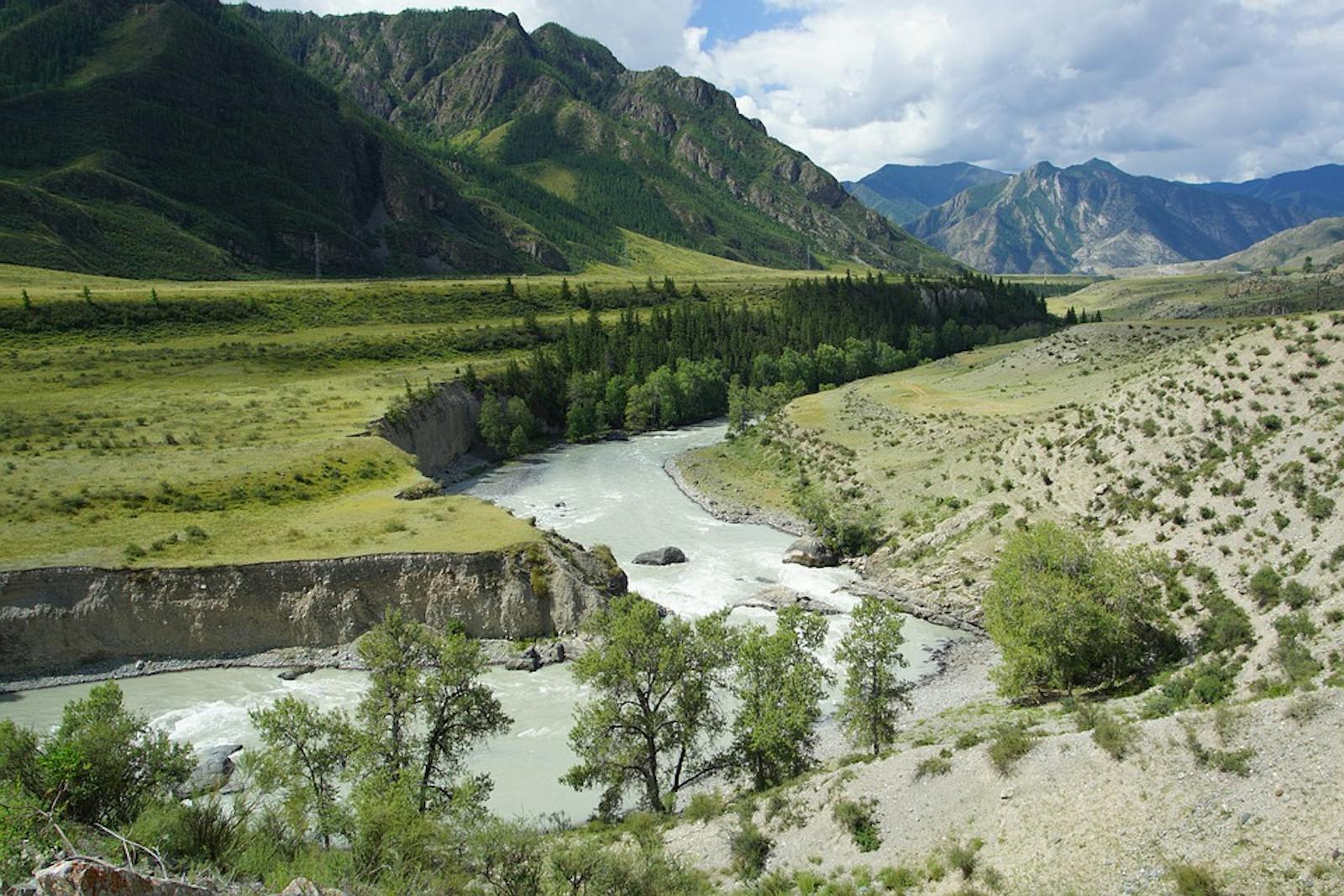Altai Montane Forest and Forest Steppe
The ecoregion’s land area is provided in units of 1,000 hectares. The conservation target is the Global Safety Net (GSN1) area for the given ecoregion. The protection level indicates the percentage of the GSN goal that is currently protected on a scale of 0-10. N/A means data is not available at this time.
Bioregion: Altai Mountains & Ermin Valley (PA37)
Realm: Central Eurasia
Ecoregion Size (1000 ha):
14,277
Ecoregion ID:
690
Conservation Target:
24%
Protection Level:
5
States: Mongolia, Russia, China, Kazakhstan
The Altai Montane Forest and Forest Steppe ecoregion traces the Altai Mountains southeastward, dividing arid basins of Inner Asia from Siberian river systems that drain to the Arctic. Here, at middle elevations of about 2,000 m, environmental variables like slope aspect and grazing pressure determine whether the landscape supports cold steppe grassland or conifer forest composed of spruce, larch, and fir. Consequently, this ecoregion supports vegetation and wildlife species with an affinity to both forest and steppe grassland realms.
Species that inhabit the Altai Mountains contend with frigid winter temperatures and arid conditions throughout much of the year. At forested elevations, the annual mean temperature is about -5°C with annual precipitation less than 500 mm, while mean winter temperatures in the coldest month of the year fall below -20°C.

The flagship species of the Altai Montane Forest and Forest Steppe ecoregion is the Pallas's cat.
Generally, the north-facing slopes of this ecoregion hold dense stands of conifer forest where a sheltering layer of snow protects seedlings from extreme winter cold and spring drought stress. Microclimates here are favorable to mosses and forbs that bloom in the understory during the summer.
Spruce-dominated Siberian taiga forest prevails in the wetter northwest of the ecoregion and in some parts of the Mongolian trans-Altai. Birch and poplar stands fill mountain gap areas. Middle elevation steppe habitat supports grasses such as Festuca and drought-tolerant Koeleria, shrubs of sea buckthorn, and the legume Caragana spinosa defend the banks of streams and rivers with dense, spiny thickets.
The southern slopes of the Altai, influenced by the arid climate of Inner Asia, have less persistent snow cover and present a more extreme environment that supports cold steppe-desert vegetation comprised of Stipa feather grass, Artemesia, wild onion, and wild amaranth; there are few trees here.
Larch is a frequent component of forests in the China-Mongolia border region. In far western Mongolia, for example, an association of larch and cedar grows in the headwater regions of the Khovd River. All in all, the Altai Mountains have the most intact sequence of vegetation zones in Western Siberia and are regarded as the biogeographic origin for numerous mountain plants of north Asia. The free-flowing, near pristine Katun River, which traverses this ecoregion, contains high-elevation mountain lakes at its headwaters with ecologically complex fish communities.
Large herbivores of the forest include Siberian roe deer and red deer, a species closely akin to the American elk; argali (the largest of the bighorn sheep) and Siberian ibex frequent higher alpine slopes.
Carnivores include wolf, red fox, Corsac fox, and Pallas’s cat in most habitats, lynx in the forest, wolverine, and badger in rockier habitats near the steppe-forest boundary. Pallas’s cat is listed as near threatened due to hunting pressure for its fur and because it is sometimes shot mistakenly as a marmot or caught in a leg trap intended for another species.
Higher elevations are especially important for conservation because they support a widely dispersed population of the globally endangered snow leopard. The Altai population is thought to be a source from which individual cats disperse into southern Siberia, Mongolia, and Kazakhstan.
Smaller carnivores include several species of weasel. The most abundant small mammals are marmot and pika. The former is a large rodent, the latter a small, short-eared genus of rabbit. Both belong to genera that are common to arctic and alpine habitats throughout the Northern Hemisphere.
Market reforms in Mongolia and China have led to an increase in livestock grazing pressure in this ecoregion, with pasture degradation, overgrazing, and the threat of desertification in some areas. Illegal logging remains a concern in some parts of this ecoregion.
Priority conservation actions for the next decade
- Control logging activities to prevent deforestation of remaining habitat.
- Control environmental impacts associated with livestock agriculture, such as overgrazing, pasture degradation, and desertification.
- Monitor impacts of climate change and design mitigation and adaptation plans.
-
-
- Devee, E. 2000. Central Asia: Kazakhstan, Russia, China, and Mongolia. https://www.worldwildlife.org/ecoregions/pa0502https://www.worldwildlife.org/ecoregions/pa0502. Accessed April 2019.
- Finch, C. 1996. Mongolia’s wild heritage. Mongolia Ministry for nature and the Environment, UNDP-GEF, WWF.
- IUCN-World Conservation Union. 1998. Documentation on World Heritage Properties (natural). World Heritage Committee. Twenty-second session. 30 November – 5 December 1998. Kyoto, Gland.
-
Cite this page: Altai Montane Forest and Forest Steppe. Ecoregion Snapshots: Descriptive Abstracts of the Terrestrial Ecoregions of the World, 2021. Developed by One Earth and RESOLVE. https://www.oneearth.org/ecoregions/altai-montane-forest-and-forest-steppe/
-



